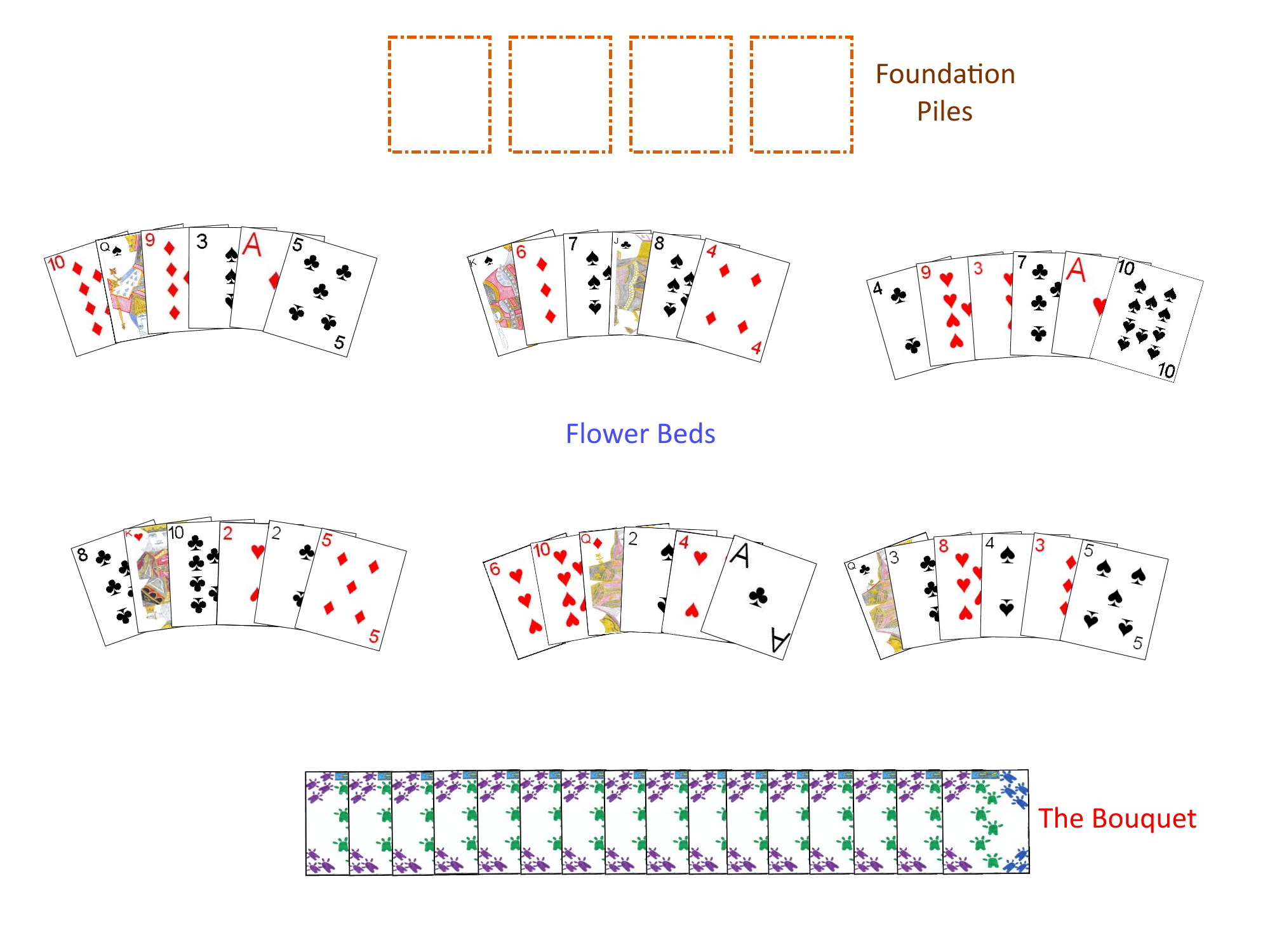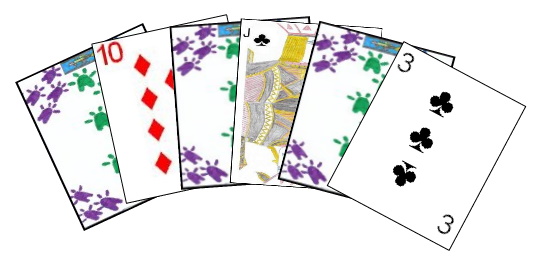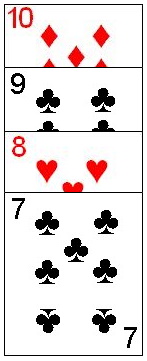
Flower Garden is a card solitaire game which, with skillful play can be won about one of every five games (or even more frequently). Flower Garden is played under several other names including "The
Bouquet" and "The Garden". Flower Garden is based on a much older Japanese Solitaire game.
Flower Garden is a form of solitaire, and is thus designed for one player. The game uses one standard 52 card deck, with the ranking of these cards shown (from highest to lowest): King, Queen, Jack, 10, 9, 8, 7, 6, 5, 4, 3, 2, Ace.
Each game should begin with a thorough shuffle of the cards by the player. After the shuffle and an optional cut, the player then deals out the layout used in the game. The player begins by dealing out six piles of face-up and overlapping cards in a slight fan shape. Each such pile should contain six cards, and be dealt in such a way that some of each card in the pile can be seen, with the exception of the top-most card in which the entire face can be seen. These piles are the "flower beds" and the entire layout is called "The Garden". The 16 cards remaining after the layout is formed is the hand, known as "The
Bouquet". These cards are often arranged on the table in large fan, such that all cards in the hand are visible. During play, any card from the
bouquet is available to play as able, but only the topmost card of each flower bed is available for play at any specific time.
Once the formation of the layout has been completed, play of the hand can begin. The ultimate object of the game is to get the entire pack formed on four foundation piles, one in each suit that will be created starting with the Aces. In order to achieve this goal, the player has a number of legal moves at his disposal:
- Start a Foundation: An Ace can be moved from the top, exposed card of any flower bed to start a new foundation pile. Similarly, any Ace found in the
bouquet (the player's hand cards) can be immediately moved to start a foundation.
- Build onto a Foundation: Once a foundation pile has been started with an Ace, further cards can be built onto this foundation as able. To play a card to a foundation pile, a card must be of the same suit and of the next higher rank than the current top card of that foundation pile. The topmost card of a flower bed can thus be played to a foundation pile, or a card from the
bouquet.
- Build onto an Existing Flower Bed: A card can be played onto the top of a flower bed if the card played is exactly one rank lower than that top card, regardless of the suit of the card. The played card then becomes the new top of that flower bed. The card so played can be the topmost card from another flower bed or a card from the
bouquet.
- Refill a Flower Bed: If the last card has been removed for play from a flower bed, leaving an empty flower bed, this flower bed can be reseeded (restarted) using the top card of another flower bed or any card in the
bouquet.
The game continues with the player making legal moves until either there are no more available moves or he manages to get all 52 cards into the four foundation piles, each building from Ace to King in one suit. If the player does manage to so get all the cards into the foundation piles, he is said to have won the game.
 Wildflower Solitaire:
Wildflower Solitaire: Wildflower Solitaire is a variant of Flower Garden which is slightly more easy to win. The game is played identically to the standard Flower Garden solitaire as described above with one modification. While in standard Flower Garden only one card may be played from one flower bed to another, in Wildflower Solitaire, a group of cards can be moved from the top of one flower bed to another. In order for this move to be legal, however, all the cards moved must be in a downward sequence and must be of the same suit. The stack can be moved to start a new flower bed (if there are any currently empty flower beds) or played on the top card of another flower bed, providing that top card is exactly one card higher in rank (regardless of suit) than the top card in the sequence of cards to be moved. Other than this one difference in the rules, Wildflower Solitaire is played identically to standard Flower Garden.
Arizona Solitaire: Arizona is a solitaire card game played very similarly to Wildflower Solitaire. In fact, Arizona is played identically to Wildflower with one exception in regards to play to the tableau piles:
A card can be played from the hand (called the reserve in this game) to the top of any tableau pile as long as the card is exactly one rank lower, but can be of any suit. Similarly, a card can be played from the top of any tableau pile to the top of another tableau pile as long as the card moved is exactly one rank lower (of any suit) than the top card of the other tableau pile onto which it is played. Similar to Wildflower Solitaire, a sequence of cards can be moved. However, while in Wildflower Solitaire all cards moved (as well as the top card of the pile the cards are played to) must be of the same suit, in Arizona Solitaire, such a sequence can be moved of cards of mixed suits. In other words, the only requirement is that the cards all form part of an actual descending sequence, which can be played onto a card on the top of another tableau pile which is exactly one rank higher than the top card of the sequence (which can also be of any suit).
In all other aspects, Arizona Solitaire is played identically to Wildflower Solitaire.
Phoenix Solitaire: Being an offshoot of Arizona Solitaire, it is fitting that this offshoot might be named after the capital city of the
U.S. state of Arizona; Phoenix. Phoenix is a somewhat more difficult to win variant of Arizona solitaire that is
otherwise played identically to Wildflower Solitaire or Arizona Solitaire, with just one difference in play, which is also related to which specific cards can be played to the top of tableau piles:
A card from the hand (called the reserve) can be played to the top of any tableau pile as long as that card is exactly one rank higher and of an opposite colored suit (red suited cards can be played on black suited cards and black suited cards can be played to red-suited cards). Similarly a card can be played from the top of any tableau pile to the top of another tableau pile as long as the card moved is exactly one rank lower than the top card of the pile it is played to and the card is of an opposite suit color. Similarly, a descending sequence of two or more cards can be played from the top of one tableau pile to the top of another as long as all the cards in the sequence are in a direct descending sequence of alternating suit colors and the top card of the pile the sequence is played to is exactly one rank higher and is of an opposite suit color than the top, highest card in the sequence which is to be moved to this pile.
In every other respect, Phoenix Solitaire is played identically to Wildflower solitaire.
Brigade Solitaire: Brigade Solitaire is another variant of Flower Garden which is designed to be slightly easier to win.
Before the deal, the four Aces are removed from the deck and are placed face-up on the table to start the four foundation piles, thus the foundation piles have already been started before play of the hand begins.
During the deal, seven tableau piles are dealt to the table, each containing five face-up cards. These tableau piles should be dealt in such a manner that all the cards are visible but only the top card in each pile is completely exposed and available for play. The remaining cards are placed in what is called the reserve pile. All cards from this reserve pile are available to be played as needed.
Other than the difference in the format of the tableau, the game is played identically to Flower Garden as described above, with the player said to have won if able to legally move all cards onto four foundation piles, one corresponding to each suit.
Stonewall Solitaire: Stonewall Solitaire is a form of Flower Garden solitaire that is rather more difficult to win. There are several differences amongst this game and Flower Garden:

- The tableau is dealt similarly to the parent game, in six fans consisting of six cards each. However, in this game, the first, third, and fifth card in each of these fans is dealt face-down, with the rest of the cards dealt face up. Once any of these face-down cards is exposed as the top card in a pile, it is then turned face-up and exposed and thus forms the new top card of that pile.
- Cards may be played onto the top card of a tableau pile as long as the card played is exactly one rank lower and is of a suit in the opposite color (i.e. a black suited card played to a red suited card or a red suited card played on a black suited card).
- A group of cards on the top of a tableau pile may all be moved together if those cards are all in descending sequence and alternate in suit color. The cards so moved may be played to start a new tableau pile (if there are five or fewer current populated tableau piles on the table) or played onto another tableau pile if the top card of that tableau pile is exactly one rank higher than the top card of the sequence and is of a suit in the opposite color.
Other than these differences, this game is played identically to Flower Garden, with the player being said to have won if successfully able to get all 52 cards into four ascending sequence foundation piles, one in each suit.
Trevi Garden: Trevi Garden is a solitaire game similar to Stonewall Solitaire but which is slightly easier to win.
The initial deal and play of Trevi Garden Solitaire is identical to Stonewall Solitaire, with the cards left after the deal of the tableau piles forming the hand or "fountain".
The feature of Trevi Garden which makes it somewhat easier to win than
it's parent game is the addition of two individual cells. These cells are two
special spots or storage locations which can contain, at most, one card each during the course of the game. These cells can be populated with the top card from any tableau pile or any card from the hand (fountain). A card currently found in one of these two cells can be played to the top of a foundation, to start a new tableau pile (if there are five or fewer such piles currently found on the table), or to the top of another tableau pile, as long as it can be legally played to that location per the standard rules of the game.
Other than this difference, Trevi Garden is played identically to it's parent game, with the player said to have won the game if he is able to legally play all 52 cards onto the four foundation piles.
 Gloucestershire Solitaire:
Gloucestershire Solitaire: Gloucestershire Solitaire can be though of as a sort of two-deck version of Flower Garden. Gloucestershire
Solitaire is thus played using two standard 52 card decks shuffled together.
During the deal, the player deals out a total of 8 tableau piles, each of which has progressively more cards. The first tableau pile has three cards, the second has four such cards, the third contains five cards, all the way up to the
eighth tableau pile which contains ten cards. The cards
in each tableau pile can arranged in a slight fan shape similar to the flower beds as in Flower Garden, however, it is more common to deal each pile in a vertical row from top to bottom. Regardless of the pattern used in dealing the cards, the cards must be dealt in such a manner that all cards are exposed and visible, but only the top card of each tableau is accessible for play. The remaining cards form a waste pile or hand, from which all cards are available for play at any time as needed.
A card (from the waste pile or the top card of a tableau pile) may be played onto the top of a tableau pile if the card played
is one rank lower and of the opposite color (red suited cards played on
black suited cards and black suit colored cards played on red suit colored cards). If any tableau pile is completely cleared, it may be restarted with any card from the waste pile or the top card from any other tableau pile.
The object of Gloucestershire Solitaire is to get all the cards formed
into four foundation piles. Each of these foundation piles must be in a
different suit which starts with the Ace and builds to the King in the
same suit. Once the pile reaches the rank of King, an Ace of that same suit can then be built onto that pile in order to
start the sequence again, building to King in the same suit. If the player manages to get all 104 cards built onto these four foundation piles, he is said to have won the game.
Copyright © 2015
CatsAtCards.com. All rights reserved.
 Flower Garden is a card solitaire game which, with skillful play can be won about one of every five games (or even more frequently). Flower Garden is played under several other names including "The
Bouquet" and "The Garden". Flower Garden is based on a much older Japanese Solitaire game.
Flower Garden is a card solitaire game which, with skillful play can be won about one of every five games (or even more frequently). Flower Garden is played under several other names including "The
Bouquet" and "The Garden". Flower Garden is based on a much older Japanese Solitaire game.


